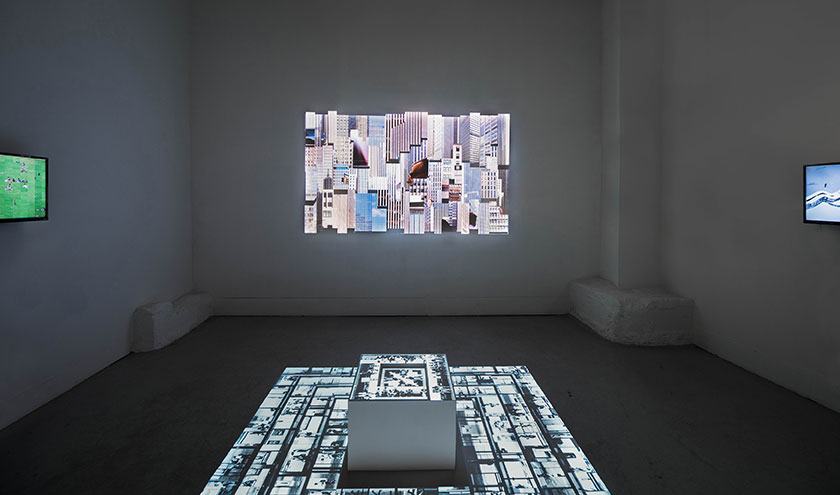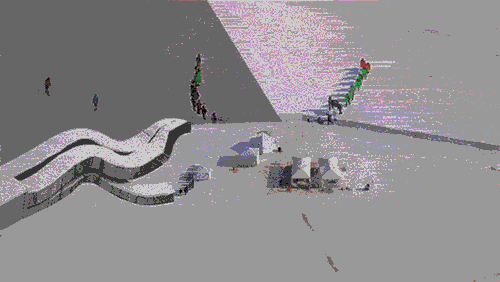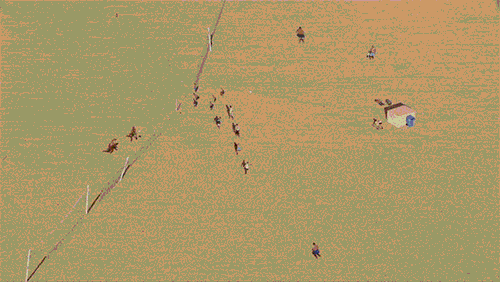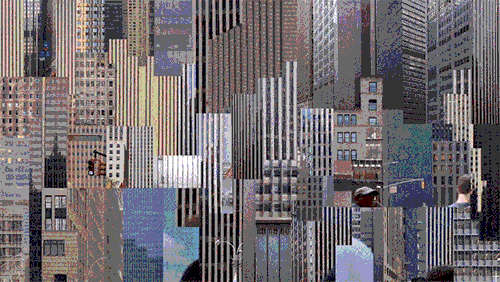Interview Simona Serban

Yuge Zhou is a Chicago-based artist, art director and curator whose work focuses on the complex intricacies of human interactions and behaviours. Zhou has a unique background, as she started studying drawing under Chinese contemporary painter Kaixi Cui 崔开玺 and continued with learning, focusing on video art, after earning both a Master’s degree of Fine Art from the School of the Art Institute of Chicago and a master’s degree in Computer Engineering from Syracuse University.
Art has the ability the challenge mentalities, introduce new ideas and concepts and, more importantly, move people, as seen in Zhou’s most recent work, Chorus of Idle Footsteps, where the artist recreates selections from past series into a new collection. The title, inspired by French scholar Michel de Certeau’s The Practice of Everyday Life, examines the ways in which we engage with mass culture as individuals. With her signature collaging and cubist strategies, the artist showcases with great craftsmanship the heaviness of the city in the video installations comes as a groundbreaking realisation of how disruptive and complex human interactions really are.
Another great example of Zhou’s artistry is the Green Play installation, revealing a seemingly ordinary moment at Central Park, one of the greatest meeting places in New York, a utopian playground for tourists and locals alike. The way the images are edited makes the general activities look more animated and active, almost like an open invitation for the viewer to step into. Green Play is part of The Humors, a four-part video collage series exploring urban dispositions.
Midtown Flutter displays the hard concrete evidence of the true effects of urban densification, the heaviness of the skyscrapers in the context of urban life, with urban life as sporadic interruptions represented by the pedestrians’ footsteps. Composed of footage of architectural patterns in midtown Manhattan, the installation is in itself a work of art due to the presentation technique used by the artist.
Her work has and gives off an ‘on the move’ type of experience, as though you caught a glimpse of an intimate moment when looking at the moving images, by highlighting normal daily activities as something to be looked at with more attention and curiosity. As an artist, Yuge reexamines our notions of individuality as she observes us unconsciously aggregate within urban environments, what she calls the ‘essential rhythm’ of a particular place.
Zhou likewise challenges the limitations of video installations in the ways she collages her footage and projects onto wall-mounted reliefs with the intricate eye of a cubist painter. Yuge currently lives and practices in Chicago, creating videos and installations that address connections, isolations and longing across urban and natural environments. She also directs and curates the 3300-square-foot 150 Media Stream, the largest new media and video art installation in Chicago.



When it comes to successful methods of finding true creativity and innovation in art, there are a lot of debates on which could be the most perfect out of them all. You also took a peculiar approach to studying art, as you started to learn one-on-one drawing with Chinese contemporary painter Kaixi Cui 崔开玺. In your opinion, could this approach be considered generally the best one or each individual has to choose his/her creative way?
While my early training focused on traditional artistic practice, I subsequently studied technology and computer because my family felt that it was a more pragmatic direction. Instead of pulling me away from art, it eventually became an unusual gateway to propel me into a more contemporary realm of art making. When I came to the United States, I picked up a camera and started shooting.
It wasn’t calculated, almost happenstance. This led me to pursue an MFA at the School of the Art Institute in Chicago, where I was able to fuse artistic concepts with the logic associated with technological innovation. This was a circuitous route: I think it shows that there is no formula for finding your passion, and in the end, one’s passions often become intertwined. You just have to pay attention to that inner voice.
You continued your education with a Master in Fine Art at the School of the Art Institute of Chicago and followed by another master’s degree in Computer Engineering at Syracuse University. Would you mind sharing the key elements you learned, found useful and still apply to your work?
I would say the key elements that I learned from computer engineering concerned logic, design, and structure. Sometimes these elements are subtle in my work. For example, in Soft Plots, a video portraying a quilt-like patchwork of volleyball and Frisbee players appearing and disappearing in sand. The actions seem random, but there is an underlying structure involving timing and location. In a more obvious example, many of my installations use reliefs with projected images precisely mapped onto panels. I enjoy pairing precision from computer engineering and conceptual thinking from artistic practices to create both novelty and order.
Your projects have a very precise way of merging both technology and raw feeling. You have demonstrated through your projects to have quite an understanding of human behaviour in relation to the urban context people are living in. Do you believe that on a subconscious level, people are aware of the lack of empathy around them and believe that by confronting them with reality in an honest and direct way, they might start behaving differently?
I am very hopeful about art’s ability to show the beauty of human behaviour and bring empathy into the world, but I am still trying to figure out how humans behave in public. There are certain things that you can count on, but there are always elements that are unpredictable. I don’t feel like my work is confrontational. In some way, it is more symbolic and archetypal; it’s also very edited and constructed; that is, it transforms what the camera captures into a mediated reality. Since I started to make art, I’m much more aware of myself in public as an observer and a participant.
I believe it’s safe to say you have indeed seen the world, different nationalities, and cultures, having had the opportunity to speak, adapt and introspect through your multiple journeys. When you first visit a place, not necessarily a new city, maybe a place in your city you haven’t visited before, what is the first thing you notice?
In new places, I first notice people’s mannerisms, both as individuals and as groups. There are obvious cultural differences in these places, but there are also universally shared emotions: relaxation, anxiety, joy, hope, indifference, and loneliness. Unfamiliarity heightens my sensitivities to what may be normal or completely transparent to the local people, but I’m always experiencing new places through my own lens. So how I read people and my response to them says as much about me as the people I encounter.
While working as a Director and Curator for The 150 Media Stream, the largest new media and video art installation in Chicago, what have you discovered interesting about people, something you didn’t use to know before? What would you say is the most important about the work you select as a curator?
One thing I noticed and appreciated is the incredible energy and curiosity people have for art, not just from artists who I work with but also the public and the tenants who encounter the 150 Media Stream in their daily life. This curatorial position puts me in touch with communities that have very different views about art making – from developers, contractors and architects to financiers and lawyers.
The program I set up for the 150 Media Stream features artists with a wide range of backgrounds, from big, international artists all the way down to high school art students. This range is very important to the mission of 150 Media Stream. It is a democratic space – anyone has an opportunity to be featured on the installation, from some superstar artists to students who make art for the first time but are very passionate about it.
Your last solo exhibition at Site:Brooklyn Gallery, Chorus of Idle Footsteps, rearranges selections from past series able to be experienced in unprecedented ways. Could you tell us a few details about the intellectual process and what the future holds following this new solo exhibition?
Each piece that was chosen for my solo exhibition, Chorus of Idle Footsteps, works around the central themes of isolation and connection in the urban environment, the confluence of individual needs and mass behaviour. The show was a great way for me to rearrange my body of work in one space and see how various pieces spoke to one another. It brought to a close the work I’ve made in the past four years and allowed me to reflect on the themes that I want to explore. It gave me a natural transition into the next chapter of art making.
The new project that I’m working on (and very excited about) is much more introspective and autobiographical, and it is devoid of people. It is a two-part video series entitled when the East of the day meets the West of the night that explores the physical and ideological distances between China and the United States and what each represents in me. The first video, filmed last fall in two locations near my previous homes in Beijing and California, looks across the Pacific Ocean. The camera slowly moves laterally as the sun descends and ascends in two skies to create an arc-shaped trajectory. The dual scenes represent the contemplating and longing for what lies beyond.
The second video will follow the same format with the rising and setting moon across mountain ranges of both countries – one during the supermoon in April in the Rocky Mountains (which is part of the Great Divide that designates the line at which waters flow either to the east and the west), and one near the Himalaya Plateau in China. Having mainly worked solo during the past four years, this new series is more ambitious and challenging in the ways that it involves collaboration with other creative professionals.
It requires me to travel to the far reaches of the US and back to my homeland amidst political tensions, to manage crews in both locations and to shoot in remote and unfamiliar places. It is a milestone in my artistic practice as I’m making a more personal statement that communicates harmony and hope for shared commonality and compassion, which is so needed at this particular time.
Beyond the videos, the second component of the new project will be a daily postcard exchange between my mother (who lives in Beijing) and me. The postcards will be printed stills from the above video of the two suns. Since the video diptych seems to run forward and backwards in time, there will be a point where the postcards from two lands will “meet” in the middle, which is right where the two suns appear simultaneously. This “meeting” will have great metaphorical and personal significance, and I am in the process of working out the details. I’m also very excited to start this daily communication with my mother.
What is your chief enemy of creativity?
Being exposed to an endless stream of content in the media-saturated internet culture, there is so much interesting work out there, but it’s the law of diminishing returns. Sometimes this makes me question whether I am capable of making something that is truly new or affective. I try to turn this kind of insecurity into something more productive by immersing myself into the nuances and details of a project. By doing so, I often realize that I don’t need to worry about being more innovative but instead trust that innovation comes from within.
You couldn’t live without…
I couldn’t live without my camera because of the excitement of experiencing new cultures and places and archiving these experiences or even going to the exact same spot to shoot at the same time every day. The world around me never stops changing and evolving into new situations and fragments that happen in front of my lens.






